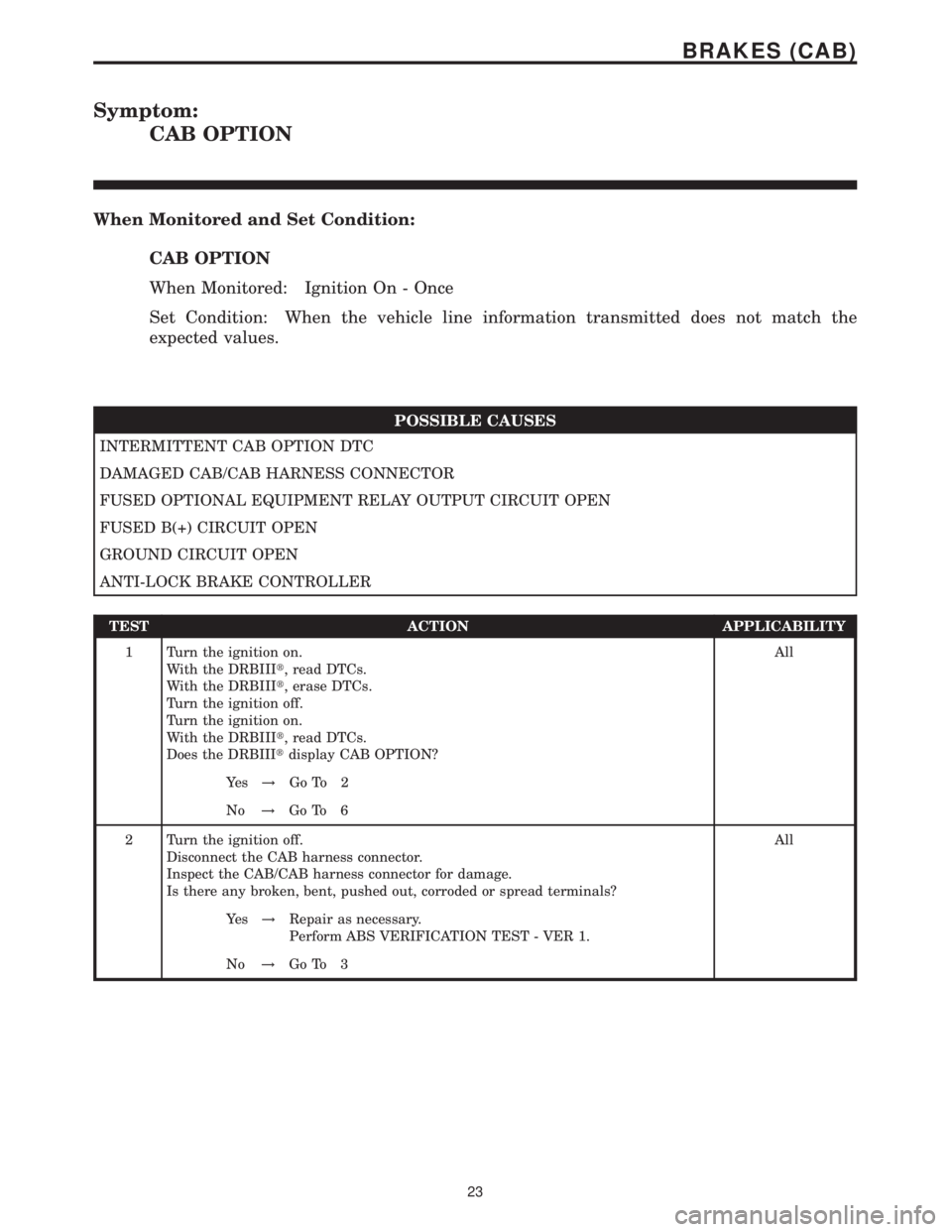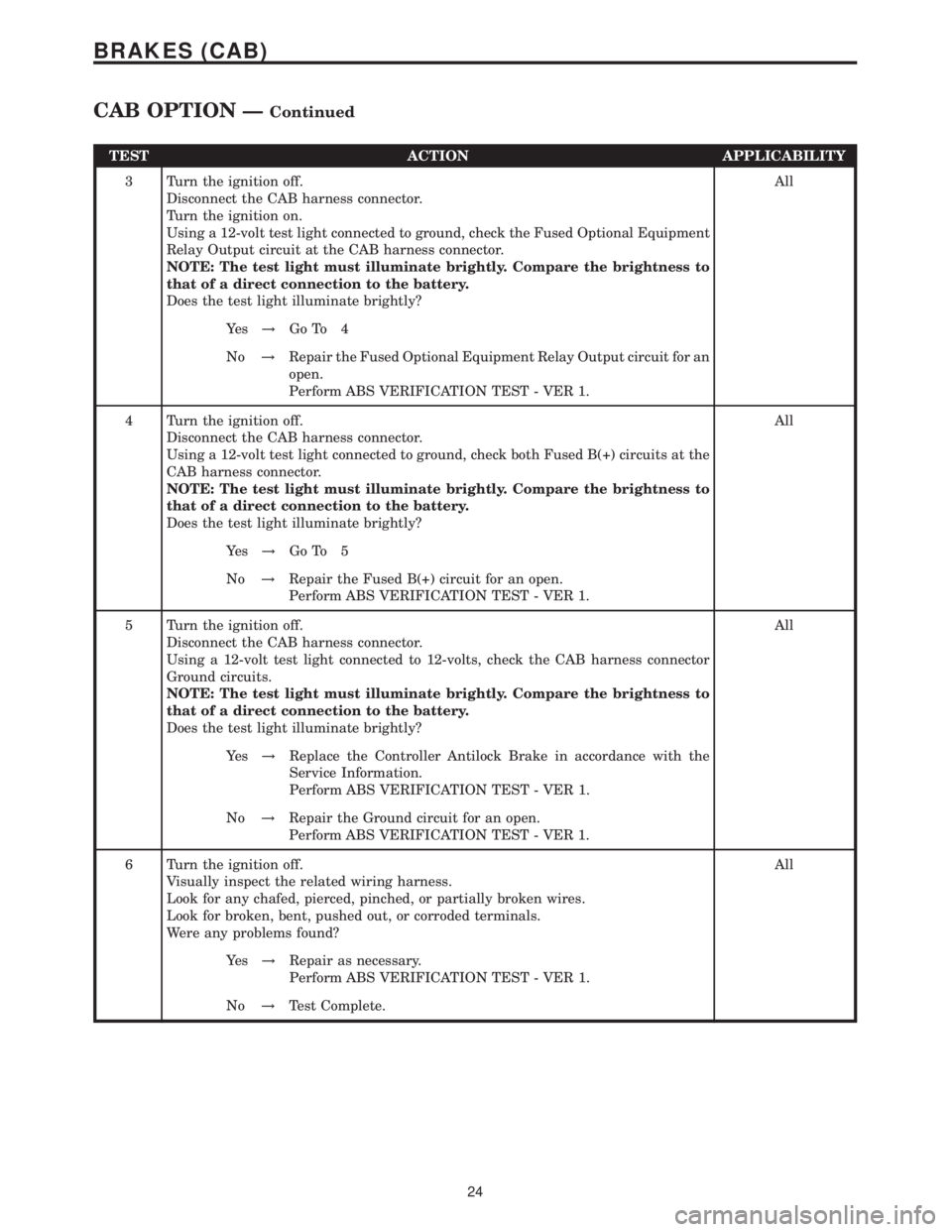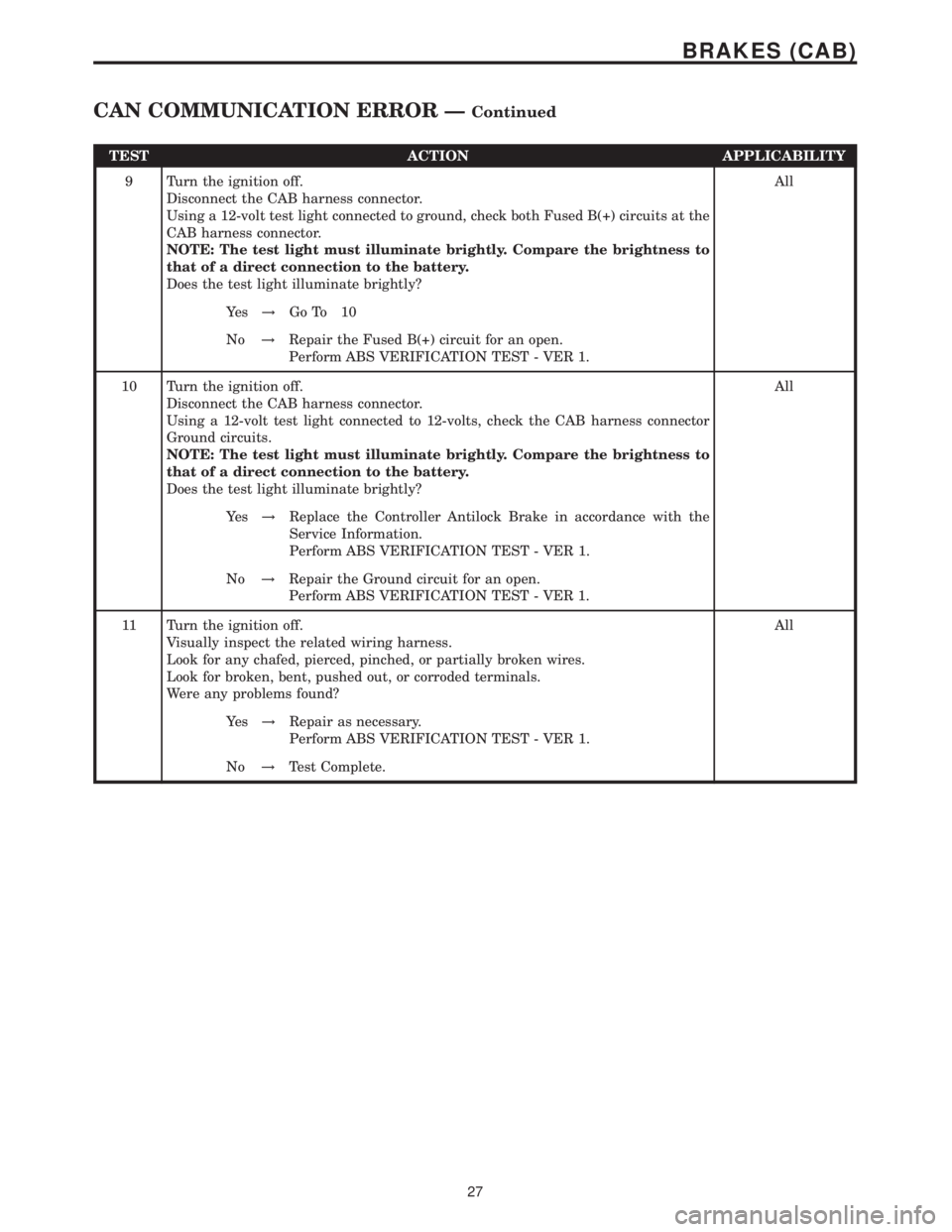2006 MERCEDES-BENZ SPRINTER lock
[x] Cancel search: lockPage 343 of 2305

TEST ACTION APPLICABILITY
3 Turn the ignition off.
Disconnect the CAB harness connector.
Turn the ignition on.
Using a 12-volt test light connected to ground, check the Fused Optional Equipment
Relay Output circuit at the CAB harness connector.
NOTE: The test light must illuminate brightly. Compare the brightness to
that of a direct connection to the battery.
Does the test light illuminate brightly?All
Ye s!Go To 4
No!Repair the Fused Optional Equipment Relay Output circuit for an
open.
Perform ABS VERIFICATION TEST - VER 1.
4 Turn the ignition off.
Disconnect the CAB harness connector.
Using a 12-volt test light connected to ground, check both Fused B(+) circuits at the
CAB harness connector.
NOTE: The test light must illuminate brightly. Compare the brightness to
that of a direct connection to the battery.
Does the test light illuminate brightly?All
Ye s!Go To 5
No!Repair the Fused B(+) circuit for an open.
Perform ABS VERIFICATION TEST - VER 1.
5 Turn the ignition off.
Disconnect the CAB harness connector.
Using a 12-volt test light connected to 12-volts, check the CAB harness connector
Ground circuits.
NOTE: The test light must illuminate brightly. Compare the brightness to
that of a direct connection to the battery.
Does the test light illuminate brightly?All
Ye s!Replace the Controller Antilock Brake in accordance with the
Service Information.
Perform ABS VERIFICATION TEST - VER 1.
No!Repair the Ground circuit for an open.
Perform ABS VERIFICATION TEST - VER 1.
6 Turn the ignition off.
Visually inspect the related wiring harness.
Look for any chafed, pierced, pinched, or partially broken wires.
Look for broken, bent, pushed out, or corroded terminals.
Were any problems found?All
Ye s!Repair as necessary.
Perform ABS VERIFICATION TEST - VER 1.
No!Test Complete.
22
BRAKES (CAB)
CAB CHECK SUM ÐContinued
Page 344 of 2305

Symptom:
CAB OPTION
When Monitored and Set Condition:
CAB OPTION
When Monitored: Ignition On - Once
Set Condition: When the vehicle line information transmitted does not match the
expected values.
POSSIBLE CAUSES
INTERMITTENT CAB OPTION DTC
DAMAGED CAB/CAB HARNESS CONNECTOR
FUSED OPTIONAL EQUIPMENT RELAY OUTPUT CIRCUIT OPEN
FUSED B(+) CIRCUIT OPEN
GROUND CIRCUIT OPEN
ANTI-LOCK BRAKE CONTROLLER
TEST ACTION APPLICABILITY
1 Turn the ignition on.
With the DRBIIIt, read DTCs.
With the DRBIIIt, erase DTCs.
Turn the ignition off.
Turn the ignition on.
With the DRBIIIt, read DTCs.
Does the DRBIIItdisplay CAB OPTION?All
Ye s!Go To 2
No!Go To 6
2 Turn the ignition off.
Disconnect the CAB harness connector.
Inspect the CAB/CAB harness connector for damage.
Is there any broken, bent, pushed out, corroded or spread terminals?All
Ye s!Repair as necessary.
Perform ABS VERIFICATION TEST - VER 1.
No!Go To 3
23
BRAKES (CAB)
Page 345 of 2305

TEST ACTION APPLICABILITY
3 Turn the ignition off.
Disconnect the CAB harness connector.
Turn the ignition on.
Using a 12-volt test light connected to ground, check the Fused Optional Equipment
Relay Output circuit at the CAB harness connector.
NOTE: The test light must illuminate brightly. Compare the brightness to
that of a direct connection to the battery.
Does the test light illuminate brightly?All
Ye s!Go To 4
No!Repair the Fused Optional Equipment Relay Output circuit for an
open.
Perform ABS VERIFICATION TEST - VER 1.
4 Turn the ignition off.
Disconnect the CAB harness connector.
Using a 12-volt test light connected to ground, check both Fused B(+) circuits at the
CAB harness connector.
NOTE: The test light must illuminate brightly. Compare the brightness to
that of a direct connection to the battery.
Does the test light illuminate brightly?All
Ye s!Go To 5
No!Repair the Fused B(+) circuit for an open.
Perform ABS VERIFICATION TEST - VER 1.
5 Turn the ignition off.
Disconnect the CAB harness connector.
Using a 12-volt test light connected to 12-volts, check the CAB harness connector
Ground circuits.
NOTE: The test light must illuminate brightly. Compare the brightness to
that of a direct connection to the battery.
Does the test light illuminate brightly?All
Ye s!Replace the Controller Antilock Brake in accordance with the
Service Information.
Perform ABS VERIFICATION TEST - VER 1.
No!Repair the Ground circuit for an open.
Perform ABS VERIFICATION TEST - VER 1.
6 Turn the ignition off.
Visually inspect the related wiring harness.
Look for any chafed, pierced, pinched, or partially broken wires.
Look for broken, bent, pushed out, or corroded terminals.
Were any problems found?All
Ye s!Repair as necessary.
Perform ABS VERIFICATION TEST - VER 1.
No!Test Complete.
24
BRAKES (CAB)
CAB OPTION ÐContinued
Page 346 of 2305

Symptom:
CAN COMMUNICATION ERROR
POSSIBLE CAUSES
CAN DTCS PRESENT IN OTHER MODULES
INTERMITTENT CAN COMMUNICATION ERROR DTC
DAMAGED CAB/CAB HARNESS CONNECTOR
CAN CIRCUIT(S) SHORT TO VOLTAGE
CAN CIRCUIT(S) SHORTED TOGETHER
CAN CIRCUIT(S) SHORT TO GROUND
CAN CIRCUIT(S) OPEN
FUSED OPTIONAL EQUIPMENT RELAY OUTPUT CIRCUIT OPEN
FUSED B(+) CIRCUIT OPEN
GROUND CIRCUIT OPEN
ANTI-LOCK BRAKE CONTROLLER
TEST ACTION APPLICABILITY
1 Turn the ignition on.
NOTE: Diagnose any Steering Angle Sensor DTCs that are present in this
module before continuing.
With the DRBIIIt, read DTCs in the Engine Control Module, Transmission Control
Module, and Instrument Cluster.
Are there any CAN communication DTCs present in any of these modules?All
Ye s!Refer to the diagnostic procedures for any CAN DTCs in ECM,
TCM and Cluster before proceeding with this test.
Perform ABS VERIFICATION TEST - VER 1.
No!Go To 2
2NOTE: If a system undervoltage or overvoltage DTC is set along with this
DTC, diagnose the system voltage DTC first.
Turn the ignition on.
With the DRBIIIt, erase DTCs.
Turn the ignition off.
Start the engine.
With the DRBIIIt, read DTCs.
Does this DTC reset?All
Ye s!Go To 3
No!Go To 11
3 Turn the ignition off.
Disconnect the CAB harness connector.
Inspect the CAB/CAB harness connector for damage.
Is there any broken, bent, pushed out, corroded or spread terminals?All
Ye s!Repair as necessary.
Perform ABS VERIFICATION TEST - VER 1.
No!Go To 4
25
BRAKES (CAB)
Page 348 of 2305

TEST ACTION APPLICABILITY
9 Turn the ignition off.
Disconnect the CAB harness connector.
Using a 12-volt test light connected to ground, check both Fused B(+) circuits at the
CAB harness connector.
NOTE: The test light must illuminate brightly. Compare the brightness to
that of a direct connection to the battery.
Does the test light illuminate brightly?All
Ye s!Go To 10
No!Repair the Fused B(+) circuit for an open.
Perform ABS VERIFICATION TEST - VER 1.
10 Turn the ignition off.
Disconnect the CAB harness connector.
Using a 12-volt test light connected to 12-volts, check the CAB harness connector
Ground circuits.
NOTE: The test light must illuminate brightly. Compare the brightness to
that of a direct connection to the battery.
Does the test light illuminate brightly?All
Ye s!Replace the Controller Antilock Brake in accordance with the
Service Information.
Perform ABS VERIFICATION TEST - VER 1.
No!Repair the Ground circuit for an open.
Perform ABS VERIFICATION TEST - VER 1.
11 Turn the ignition off.
Visually inspect the related wiring harness.
Look for any chafed, pierced, pinched, or partially broken wires.
Look for broken, bent, pushed out, or corroded terminals.
Were any problems found?All
Ye s!Repair as necessary.
Perform ABS VERIFICATION TEST - VER 1.
No!Test Complete.
27
BRAKES (CAB)
CAN COMMUNICATION ERROR ÐContinued
Page 350 of 2305

Symptom:
DRIVE TEST ERROR
POSSIBLE CAUSES
INTERMITTENT DRIVE TEST ERROR DTC
STEERING COMPONENT INSPECTION
LATERAL ACCELERATION SENSOR CIRCUIT SHORT TO VOLTAGE
LATERAL ACCELERATION SENSOR CIRCUIT SHORT TO GROUND
LATERAL ACCELERATION SENSOR CIRCUIT OPEN
LATERAL ACCELERATION SENSOR
ANTI-LOCK BRAKE CONTROLLER
TEST ACTION APPLICABILITY
1 Turn the ignition off.
Turn the ignition on.
With the DRBIIIt, read DTCs. Record DTC information.
NOTE: If any other DTC is set along with this DTC, diagnose the other
DTC(s) first.
NOTE: Electromagnetic (radio) interference can cause an intermittent
system malfunction by interrupting communication between the sensor
and the CAB.
With the DRBIIIt, erase DTCs.
With the DRBIIIt, perform the road test procedure in accordance with the Service
Information.
With the DRBIIIt, read DTCs.
NOTE: Failure to perform the road test procedure properly can cause this
DTC to set.
NOTE: This DTC can only be cleared by a fault free road test.
Does this DTC reset?All
Ye s!Go To 2
No!Go To 7
2NOTE: When the vehicle is in a turn, the ESP compares the Steering Angle
Sensor value and the speed of the inner and outer wheels to determine if the
values are plausible.
Inspect the front end and steering components for damage or misalignment.
Inspect the Lateral Acceleration Sensor for correct mounting and installation.
Inspect the tires and wheels to make sure that they are the correct size. All tires must
be the same size.
Were any problems found?All
Ye s!Repair or replace components as necessary in accordance with the
Service Information.
No!Go To 3
29
BRAKES (CAB)
Page 353 of 2305

Symptom:
INCORRECT TONE WHEEL
When Monitored and Set Condition:
INCORRECT TONE WHEEL
When Monitored: Ignition On - Continuously
Set Condition: When continuous ABS control is active for one minute on one or more
wheels OR interference on one or more wheels OR deviation of two wheel speeds at either
side of vehicle by 6 km/h (4 mph) or at the front axle by 10 km/h (7 mph). If at least one
wheel is 5 km/h (3 mph) or less, a wheel speed deviation of adjoining wheels of 12 km/h (8
mph) is allowed.
POSSIBLE CAUSES
INTERMITTENT INCORRECT TONE WHEEL DTC
INCORRECT TIRES ON VEHICLE
TIRE CIRCUMFERENCES NOT MATCHING
WHEEL SPEED SENSOR CIRCUIT SHORT TO VOLTAGE
INCORRECT TONE WHEEL
WHEEL SPEED SENSOR CIRCUIT SHORT TO GROUND
DAMAGED WHEEL BEARING
WHEEL SPEED SENSOR CIRCUIT OPEN
DAMAGED BRAKE LININGS/COMPONENTS
WHEEL SPEED SENSOR CIRCUITS SHORTED TOGETHER
WHEEL SPEED SENSOR
TEST ACTION APPLICABILITY
1 Turn the ignition on.
With the DRBIIIt, read DTCs.
With the DRBIIIt, erase DTCs.
Turn the ignition off.
Turn the ignition on.
Road test the vehicle.
During the road test, drive the vehicle above 100 km/h (62 mph) for at least 3 minutes
and perform several stops and Antilock stops.
Stop the vehicle.
With the DRBIIIt, read DTCs.
Does the DRBIIItdisplay INCORRECT TONE WHEEL?All
Ye s!Go To 2
No!Go To 13
32
BRAKES (CAB)
Page 354 of 2305

TEST ACTION APPLICABILITY
2 Turn the ignition off.
Inspect the tire sizes on the vehicle.
Is a smaller than production tire or spare tire being used?All
Ye s!Repair as necessary.
Perform ABS VERIFICATION TEST - VER 1.
No!Go To 3
3 Turn the ignition off.
Measure all the tire circumferences.
Do all the tire circumferences match?All
Ye s!Go To 4
No!Repair as necessary.
Perform ABS VERIFICATION TEST - VER 1.
4 Turn the ignition off.
Inspect the tone wheel(s) for damage, missing teeth, cracks, or looseness.
NOTE: Refer to the service manual information, if necessary, for procedures
or specifications.
Are one or more tone wheel(s) loose or damaged?All
Ye s!Repair as necessary.
Perform ABS VERIFICATION TEST - VER 1.
No!Go To 5
5 Turn the ignition off.
Inspect the wheel bearings for excessive runout or clearance.
NOTE: Refer to the service information, if necessary, for procedures or
specifications.
Is the wheel bearing clearance within specifications?All
Ye s!Go To 6
No!Repair as necessary.
Perform ABS VERIFICATION TEST - VER 1.
6 Turn the ignition off.
Visually inspect the brakes for locking up due to lining contamination or overheating.
Inspect all brake components for any condition that would cause a variation in wheel
speed.
Is any component damaged?All
Ye s!Repair as necessary.
Perform ABS VERIFICATION TEST - VER 1.
No!Go To 7
7 Turn the ignition on.
With the DRBIIItin Sensors, monitor ALL the Wheel Speed Sensor signals while an
assistant drives the vehicle.
Slowly accelerate from a stop to 65 km/h (40 mph).
NOTE: Wheel Speed should not vary by more than 10% from wheel to wheel
when driving in a straight line.
Do any of the Wheel Speed Sensor signals vary by greater than 10% while driving in
a straight line?All
Ye s!Go To 8
No!Go To 13
33
BRAKES (CAB)
INCORRECT TONE WHEEL ÐContinued